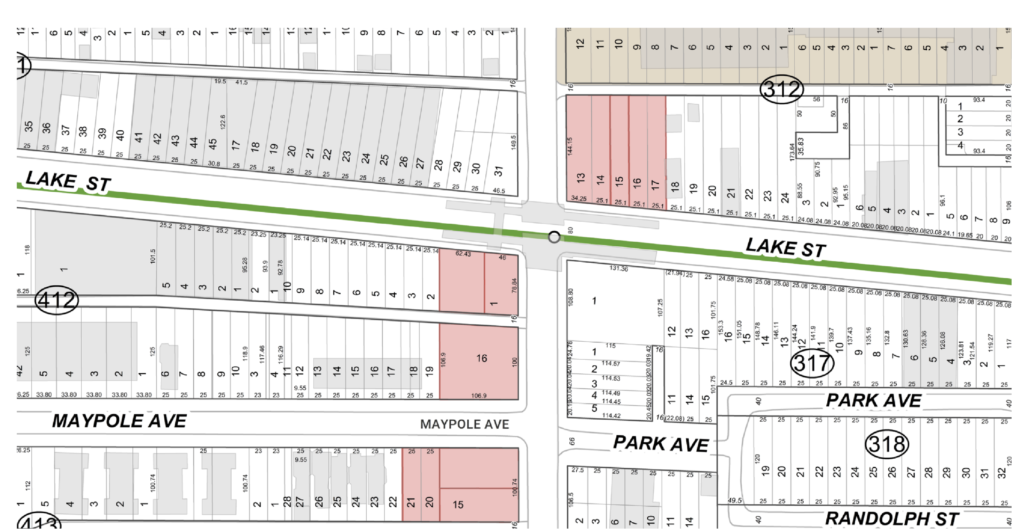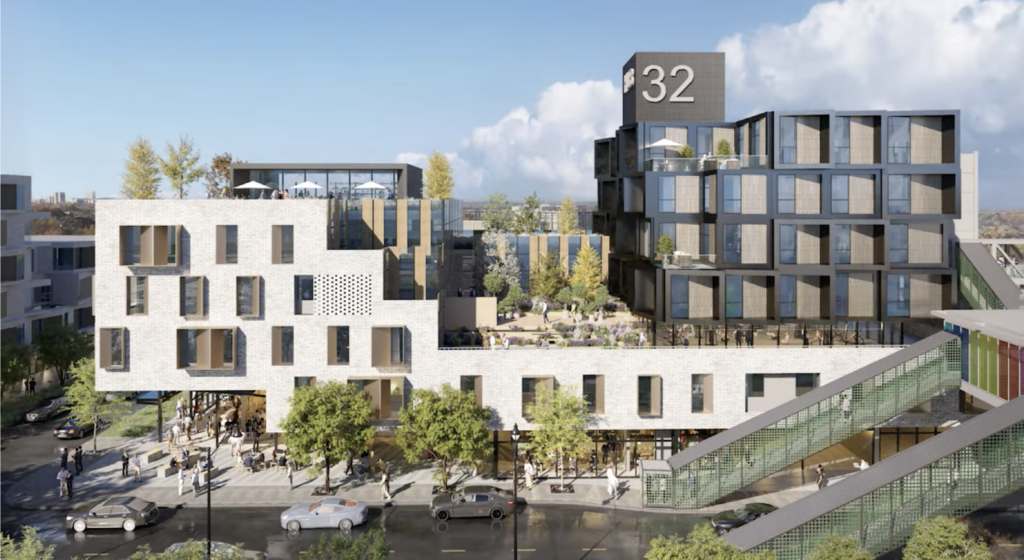The Chicago City Council has approved updated plans for the Hub 32 development at 132 North Kedzie Avenue in East Garfield Park. Bound by West Maypole Avenue to the south, the project will rise next to the CTA Green Line Kedzie station and across the street from The Hatchery. The project was first revealed in 2023 as part of a city RFQ.

Multi-site map of East Garfield Park RFQ, current site in center via Chicago DPD
The city’s original RFQ included three lots: the Hub 32 site, the lot directly to the south across Maypole, and a third lot on the northeast corner across the train tracks. The additional sites are expected to be developed at a future date. The current winning team behind Hub 32 consists of the Michaels Organization, KMW Communities, and TruDelta Real Estate.

PREVIOUS rendering of Hub 32 via Chicago DPD
Designed by Brooks + Scarpa and Studio Dwell, the original proposal called for a seven-story building with 5,600 square feet of commercial space, 16 parking spaces, and 63 affordable units. Since then, the plans have been slightly scaled back, but the structure has maintained much of its original character, clad in a mix of brick and corrugated metal.

Ground floor plan of Hub 32 by Brooks + Scarpa and Studio Dwell

Floor plan of Hub 32 by Brooks + Scarpa and Studio Dwell
Now set to rise five stories, the updated plan includes 3,800 square feet of ground-floor retail space—previously earmarked for a Jerky Jerk Caribbean restaurant outpost and a new location for Vietfive Coffee. The remainder of the first floor will contain a lobby, fitness room, office space, and a 12-car parking garage.

Elevations of Hub 32 by Brooks + Scarpa and Studio Dwell
The upper levels will house 51 residential units made up of one-, two-, and three-bedroom layouts, all of which are expected to be affordable. Some units will feature small terraces along the setbacks. The project’s overall cost is approximately $48 million, with no construction schedule or plans for future phases yet announced.
Subscribe to YIMBY’s daily e-mail
Follow YIMBYgram for real-time photo updates
Like YIMBY on Facebook
Follow YIMBY’s Twitter for the latest in YIMBYnews


$48,000,000 to construct 51 affordable units ; ridiculous .
no price to high to make an “Affordable Home” LOL
*too high
And that’s just the _estimated_ budget….sheesh.
Agreed.
For the 125th time: Affordable housing refers to units set aside to be sold or rented at below-market rates. It has little correlation with construction costs. Please spend 10 minutes on Google to discover the many reasons affordable buildings are more expensive to build than market-rate housing. It’s an absolutely flawed system, but it’s a primary way to create large numbers of below-market units at the same time. You’ll also find this is a national problem that and not a Chicago-bashing opportunity.
Instead of telling people to just “google it for yourself”, it’d proably be an order of magnitude more effective for your argumwent to just post the links that explain why it costs nearly $1M/unit to build these kinds of “affordable” housing projects.
The guys building stick frame 3-flats on vacant lots in places like North Lawndale can build units for like 1/4 the cost. Why not give those guys the $48M and let them build 4x the number of units? Isn’t housing 4 households in need better than housing 1 household in need?
I went ahead and googled it, and found some very interesting information about how much affordable housing costs around the US and why that is. Chicagoyimby does not appear to want me to share that here though, sorry.
I think they don’t allow links. Can you share what you found, but make it look like it’s not a link?
The ability to share links and pics is what I miss most about Curbed and Urbanize. But I’m not paying for a site with minimal improvement since monetization.
Some of my opinions are aggressive, but I base a decent amount of my critique on factual sources. I miss sharing when I could easily post a link or image. Now aesthetically, no one can justify their own. That’s based on faith. lol
Hey Drew,
While you can’t post images, you can post links! We will just review them to make sure it’s nothing crazy, so they may take longer to clear.
Thanks for reading!!
Next time it comes around, I’ll try again.
I find that most links I try to add never send the comment. Or it’s in pre-approval purgatory and I don’t realize.
Is there a best etiquette for link format? I see Daniel’s links, but I wasn’t sure if that was admin privileges.
Create a flashy render to win a bid, scale it back significantly after budgeting and present the building you planned to build all along. Business as usual.
Poster child for why new, “affordable” housing in Chicago is evidently impossible to build. No political leaders seem willing to chip away at the conditions which have led to this.
To be fair, no political leaders in the entire country have the will to chip away at the conditions and fundamentally change LIHTC, the red tape, etc… Direct funding would be a great first step, and what we used to do.
The new design isn’t quite as good as the original, but it is still a nice looking building. I hope they can get construction underway soon.
The community will be happy with the progress coming to their area and have the young families the opportunity to get good PW, paying jobs.,
Excellent.
These projects are about creating jobs for political constituencies. “Affordable housing” is expensive for the same reason all public construction costs in the US are so high. It’s not about Chicago, or Illinois, or about housing. It’s about dysfunctional politics in the US as a whole. The actual changes in zoning, public transit, tax structures, and public services that would support the private development of middle income housing are political impossible so we get these projects instead.